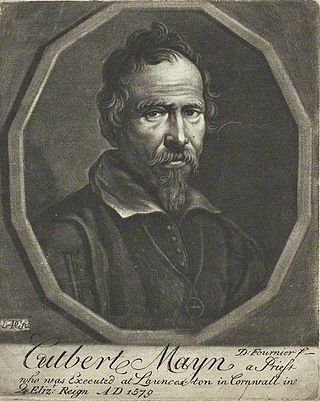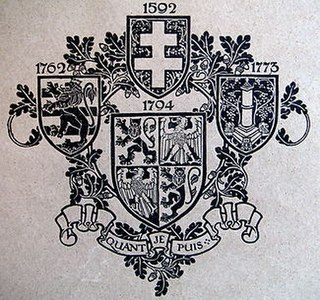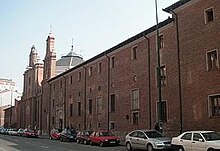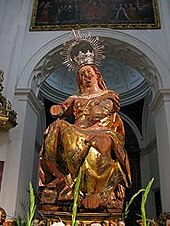
William Allen, also known as Guilielmus Alanus or Gulielmus Alanus, was an English Cardinal of the Roman Catholic Church. He was an ordained priest, but was never a bishop. His main role was setting up colleges to train English missionary priests with the mission of returning secretly to England to keep Roman Catholicism alive there. Allen assisted in the planning of the Spanish Armada's attempted invasion of England in 1588. It failed badly, but if it had succeeded he would probably have been made Archbishop of Canterbury and Lord Chancellor. The Douai-Rheims Bible, a complete translation into English from Latin, was printed under Allen's orders. His activities were part of the Counter Reformation, but they led to an intense response in England and in Ireland. He advised and recommended Pope Pius V to pronounce Elizabeth I deposed. After the Pope declared her excommunicated and deposed, Elizabeth intensified the persecution of her Roman Catholic religious opponents.

The Forty Martyrs of England and Wales or Cuthbert Mayne and Thirty-Nine Companion Martyrs are a group of Catholic, lay and religious, men and women, executed between 1535 and 1679 for treason and related offences under various laws enacted by Parliament during the English Reformation. The individuals listed range from Carthusian monks who in 1535 declined to accept Henry VIII's Act of Supremacy, to seminary priests who were caught up in the alleged Popish Plot against Charles II in 1679. Many were sentenced to death at show trials, or with no trial at all.

Cuthbert Mayne was an English Catholic priest executed under the laws of Elizabeth I. He was the first of the seminary priests trained on the Continent to be martyred. Mayne was beatified in 1886 and canonised as one of the Forty Martyrs of England and Wales in 1970.

Ambrose Edward Barlow, O.S.B. was an English Benedictine monk. He is one of a group of saints canonized by Pope Paul VI who became known as the Forty Martyrs of England and Wales.
John Gother, also known as John Goter, was an English convert to Catholicism, priest, controvertist and eirenicist.
Mark Barkworth, OSB was a Catholic priest, oblate of the Order of St Benedict, and martyr.
John Nelson was an English Jesuit martyr who was executed during the reign of Elizabeth I.

Roger Filcock, SJ was an English Jesuit priest. He was beatified as a Catholic martyr by Pope John Paul II on 22 November 1987.
The English College was a Catholic seminary in Douai, France, associated with the University of Douai. It was established in 1568, and was suppressed in 1793. It is known for a Bible translation referred to as the Douay–Rheims Bible. Of over 300 British priests who studied at the English College, about one-third were executed after returning home. The dissolution of the college at the time of the French Revolution led to the founding of Crook Hall near Lanchester in County Durham, and St Edmund's College, Ware. It is popularly believed that the indemnification funds paid by the French for the seizure of Douai's property were diverted by the British commissioners to complete the furnishings of George IV's Royal Pavilion at Brighton.

Luke Kirby was an English Catholic priest and martyr from the North of England, executed during the reign of Elizabeth I. He is one of the Forty Martyrs of England and Wales.
The Royal Scots College is a major seminary in Salamanca, Spain, for the Catholic Church in Scotland. It was located originally at Madrid, then Valladolid, and has been in Salamanca since 1988.
The Venerable English College, commonly referred to as the English College, is a Catholic seminary in Rome, Italy, for the training of priests for England and Wales. It was founded in 1579 by William Allen on the model of the English College, Douai.

Thomas Sprott, also spelled Thomas Spratt, was an English martyr, as was his colleague, Thomas Hunt, who is also known as Thomas Benstead.

Arthur "Francis" Bell, OFM was an English Franciscan friar. He was found guilty of being a Catholic priest by a court sitting under the auspices of Parliament during the English Civil War. He was executed at Tyburn in London. Bell was beatified by Pope John Paul II on 22 November 1987.
A priest hunter was a person who, acting on behalf of the English and later British government, spied on or captured Catholic priests during Penal Times. Priest hunters were effectively bounty hunters. Some were volunteers, experienced soldiers or former spies.

The Colleges of St Omer, Bruges and Liège were successive expatriate institutions for Roman Catholic higher education run by the Jesuits for English students.

Ralph Corbie, SJ was an Irish Jesuit. A victim of the anti-Catholic persecutions following the Reformation, he was beatified in 1929.
The English College of St Gregory was an English Catholic seminary in Seville, Spain. It was founded by the English Jesuit Robert Persons in 1592, when Roman Catholicism was illegal in England, to provide his native country with priests. The dedication of the college to St Gregory recalls the Gregorian mission of AD 596, which resulted in the Anglo-Saxons being converted to Christianity.
Edward Thwing was an English Catholic priest and martyr.

Thomas Reynolds, born Thomas Green, was an English Reformation Catholic priest and martyr.












